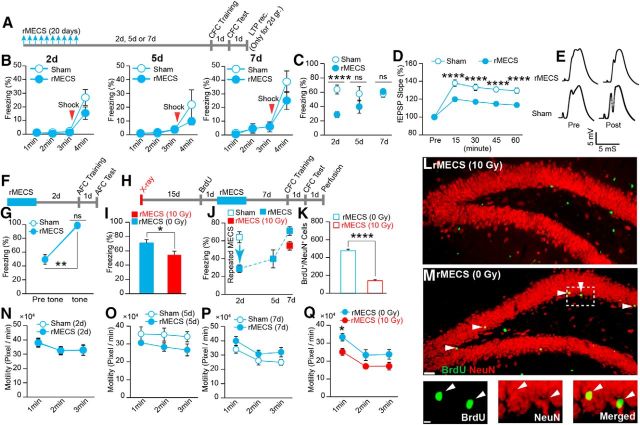Figure 5.
Adult hippocampal neurogenesis facilitates recovery from rMECS-induced impairment of CFC. A, Experimental schedule. Top arrows indicate the MECS induction. B, Freezing time during the training session. (left: rMECS-2d group, two-way ANOVA, p = 0.1200, F1,24 = 2.599, n = 13 rats/group; middle: rMECS-5 d group, two-way ANOVA, p = 0.4028, F1,11 = 0.7571, rMECS, n = 7; sham, n = 6 rats; right: rMECS-7d group, two-way ANOVA, p = 0.3691, F1,23 = 0.8394 rMECS, n = 15; sham, n = 10 rats). C, Mean freezing response during the test. rMECS-2d groups (unpaired t test, p < 0.0001, t24 = 4.72, n = 13 rats/group), 5 d groups (unpaired t test, p = 0.20, t11 = 1.33, rMECS, n = 7; sham, n = 6 rats), or 7 d groups (unpaired t test, p = 0.58, t23 = 0.55, rMECS, n = 15; sham, n = 10 rats) after the last MECS. D, LTP induction in PP–DG synapses after CFC (two-way ANOVA, p = 0.0002, F1,15 = 25.04, Bonferroni corrected, sham, n = 7; rMECS, n = 10 rats). E, Example traces of evoked fEPSP responses recorded before (pre) and after (post) tetanization. F, Experimental schedule for AFC. G, Averaged freezing response before tone (pre) and during (tone) tone period (Wilcoxon matched-pairs signed-rank test; rMECS pre-tone vs tone, p = 0.003, sham pre-tone vs tone, p = 0.002; rMECS tone vs sham tone, Mann–Whitney test, p = 0.19, Mann–Whitney U = 29; sham, n = 10; rMECS, n = 9 rats). H, Experimental schedule for CFC. I, Freezing response during the CFC test (unpaired t test, p = 0.02, t18 = 2.41, n = 10 rats/group). J, Summary of the behavioral results. K, Number of BrdU+/NeuN+ double-positive cells (n = 4 rats/group, unpaired t test, p < 0.0001, t6 = 16.99). L, M, Hippocampal coronal section from rMECS-irradiated rats (L) and rMECS-nonirradiated rats (M). Scale bar, 200 μm. Arrowheads indicate BrdU+/NeuN+ double-positive cells. Magnified images from an rMECS-nonirradiated rat (M; bottom); BrdU (left), NeuN (middle), and merged (right). Scale bar, 50 μm. N–Q, Motility of the sham- or rMECS-treated animals on 2 d (N, two-way ANOVA, p = 0.99, F1,24 = 5.6e–006; n = 13 rats/group), 5 d (O, two-way ANOVA, p = 0.09, F1,11 = 3.40, rMECS, n = 7; sham, n = 6), and 7 d (P, two-way ANOVA, p = 0.09, F1,23 = 2.96, rMECS, n = 15; sham, n = 10) from the last MECS. Q, Effect of rMECS and x-ray irradiation on the motility of the animals during their training session 7 d after the last MECS (two-way ANOVA, p = 0.0067, F1,18 = 9.37, rMECS irradiated vs rMECS nonirradiated, 1 min, p = 0.03, Bonferroni corrected, n = 10 rats/group). *p < 0.05, **p < 0.01, ***p < 0.001, ****p < 0.0001; ns, not significant.

